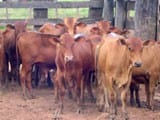



Deforestation in the Amazon has expanded since the Brazilian government began promoting the occupation of the region in the late 1960’s. Since the late 1970’s Brazil has enacted policies against deforestation with mixed results. By 2008, 15% of the original forest had been cleared. The debate about climate change, however, has facilitated policies and market pressures against deforestation. Cattle ranching, which accounts for about 75% of the area deforested, has been a major target of policies that have helped to reduce the deforestation rate by 45% in 2009 in comparison to 2008. Is this situation sustainable or is deforestation likely to rebound due to growing food demand? We used the scenario method to consider this question.
We projected three possible scenarios considering predominant trends such as concerns about climate change and about the negative impacts of environmental law enforcement on the livelihoods of small landholders and outcomes of critical uncertainties such as changes in forest and environmental laws, payment for avoided deforestation, level of concentration and informality of the meatpacking industry.
In the low deforestation scenario, pressure and incentives for forest conservation from market and public policies would be consistent. In a scenario with medium deforestation, there would be no significant change in the Forest Code and the government would continue command and control policies mostly against large landholdings. However, neither the government nor the market would provide incentives for environmental compliance.
Download the file here
Legal deforestation could grow throughout areas made accessible by new transport infrastructure. The high deforestation scenario would be similar to that of medium deforestation, with the exception that Congress and the courts would reduce forest protection by changing laws and reducing protected areas. We conclude with considerations of how the understanding of these scenarios could help in combining
market and public policies favorable to reach near zero deforestation.
This post was published on 27 de maio de 2011
Amorim, L., Ferreira, R., Dias, M., Souza Jr., C., & Veríssimo, A. Sistema de Alerta…
Título Índice de Progresso Social Brasil 2025 Autores Melissa Wilm Daniel Santos Beto Veríssimo Marcelo…
Amorim, L., Ferreira, R., Dias, M., Souza Jr., C., & Veríssimo, A. Sistema de Alerta…
Título Relatório Anual do Desmatamento no Brasil - RAD2024 Autores Carolina Del Lama Julia Shimbo…
Título Fatos da Amazônia 2025 Autores Daniel Santos Manuele Lima Agatha Vilhena Beto Veríssimo Caíque…
Amorim, L., Ferreira, R., Dias, M., Souza Jr., C., & Veríssimo, A. Sistema de Alerta…